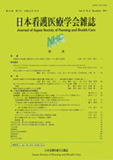Japanese
English
- 有料閲覧
- Abstract 文献概要
- 参考文献 Reference
- サイト内被引用 Cited by
要旨
本学における老年看護学の学部基礎教育のあり方を検討するための資料を得ることを目的に、第1学年と第4学年の看護学生が高齢者に対して抱いているイメージと知識・理解、高齢者とのコミュニケーション場面の特徴、および属性による相違を明らかにした。方法は、無記名の自記式質問紙で行い、分析対象数(回収率)は、第1学年76名(92%)、第4学年46名(52%)であった。高齢者から世話を受けた学生が受けない学生よりもポジティブなイメージが強く、高齢者との関わり経験の有る学生が無い学生よりもエイジズムの態度が低かった。場面設定患者(65歳)への対応の記載内容は、第1学年は【希望的観測】や【説明・説得】が約3〜4割と多く、第4学年は【共感・傾聴】が7割以上を占め(p<0.0001)、高齢者との関わり経験よりも、教育課程の違いによる学年別で特徴がみられた。以上より、高齢者に対するポジティブなイメージと態度を養うための看護教育と、高齢者に対する「傾聴」の実践的教育のあり方について考察した。
Abstract
In order to obtain data for basic undergraduate education in geriatric nursing at our university, the present study elucidated the image, knowledge, and understanding of the elderly among first- and fourth-year nursing students and the characteristics of their communication with elderly individuals, as well as differences by attributes. An anonymous self-report questionnaire survey was conducted and responses from 76 first-year students(response rate, 92%) and 46 fourth-year students(52%) were analyzed. Students with experience of receiving care from elderly individuals had a more positive image of the elderly than those with no such experience, and students with experience interacting with elderly individuals exhibited less ageism than those with no such experience. In addition, analysis of descriptions of responses to settings involving 65-year-old patients demonstrated that "wishful thinking" and "explanation and persuasion" accounted for approximately 30-40% of responses among first-year students and that "sympathizing and listening" accounted for over 70% of responses among fourth-year students (p<0.0001). Characteristics differed more considerably by school year than by presence or absence of experience interacting with elderly individuals. Based on these findings, we discussed methods for gerontological nursing education that promote positive images and attitudes toward the elderly as well as practical education involving "listening" to elderly individuals in communication settings.
Copyright © 2011, Japan Society of Nursing and Health Care All rights reserved.


